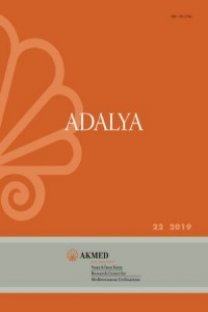Antalya Yivli Minare arkeometri çalışmaları
Archaeometric studies at Yivli Minare in Antalya
___
- Black v.d. 1965 C. A. Black - D. D. Evans - L. E. Ensminger - J. L. White - F. E. Clark, Methods of Soil Analysis No. 9 in the Series Agronomy, American Society of Agronomy, Inc., Madison, Wisconsin, USA (1965).
- Brindley - Brown 1980 G. W. Brindley - G. Brown, Crystal Structures of Clay Minerals and Their X-ray Identifications, Mineral Society (1980).
- Feigl 1966 F. Feigl, Spot Test in Organic Analysis, Elsevier Publication Company (1966).
- Hurlbut 1971 C. S. Hurlbut, Dana's Manual of Mineralogy (1971).
- Kerr 1977 P. F. Kerr, Optical Mineralogy (1977).
- Means - Parcher 1963 R. E. Means-J. V. Parcher, Physical Properties of Soils (1963).
- Özçilingir-Akgün 1997 S. Özçilingir-Akgün, Study of the Glazed Building Materials on Some Seljuk Period Buildings (ODTÜ Fen Bilimleri Enstitüsü Arkeometri Anabilim Dalı Yüksek Lisans Tezi, Ankara 1997).
- Pollard - Heron 1996 A. M. Pollard - C. Heron, "Archaeological Chemistry", The Royal Society of Chemistry (1996).
- Rapp 2002 G. Rapp, "Archaeomineralogy" (2002).
- RILEM 1980 RILEM, "Research and Testing", Materials and Construction 13 (1980) 73.
- Ulusay v.d. 2005 R. Ulusay - C. Gökçeoylu - A. Binal, "Kaya Mekaniği Laboratuar Deneyleri",TMMOB Jeoloji Müh. Odası Yayınları 58 (2005).
- Wentworth 1922 C. K. Wentworth, Â Scale of Grade and Class Terms for Clastic Sediments,Journal of Geology 30, 1922, 377-392.
- Yılmaz 2002 L. Yılmaz, Antalya (16. Yüzyılın Sonuna Kadar) (2002).
- ISSN: 1301-2746
- Yayın Aralığı: 1
- Başlangıç: 1996
- Yayıncı: Koç Üniversitesi AKMED (Suna & İnan Kıraç Akdeniz Medeniyetleri Araştırma Merkezi)
Likra'daki ünik bir keşif: Myra'nın Limanı Andriake'deki antik sinagog
Özgü ÇÖMEZOĞLU, İnci TÜRKOĞLU, Nevzat ÇELİK, Hüseyin Sami ÖZTÜRK
Kuzeydoğu Akdeniz Bölgesinde Yeni Bir Epipaleolitik Merkez: Direkli Mağarası, Kahramanmaraş
Adana Müzesi'ndeki altıgen gövdeli buhurdan
Antalya Yivli Minare arkeometri çalışmaları
Şahinde DEMİRCİ, Yusuf Kağan KADIOĞLU, Ali Akın AKYOL
Rhodiapolis Piskoposluk Kilisesi kazılarından üç mimari plastik eser üzerine değerlendirmeler
Likra şehirciliğinin ünik bir örneği Rhodiapolis
İsa KIZGUT, Süleyman BULUT, Nevzat ÇELİK
Lykia Olympos'unda bir restitüsyon denemesi
Zeliha DEMİREL GÖKALP, Şener YILDIRIM
Korykion Antron ve Göztepesi: eski problemler, yeni bulgular, yeni çözüm önerileri
Hamdi ŞAHİN, Fethi Ahmet YÜKSEL, Ziya GÖRÜCÜ
Türkiye'deki Roma İmparatorluk Dönemi lahitleri genel bir bakış (kaynakça eki ile)
